汽车专业英语U1 L2(发动机部分)讲解
- 格式:ppt
- 大小:3.80 MB
- 文档页数:45
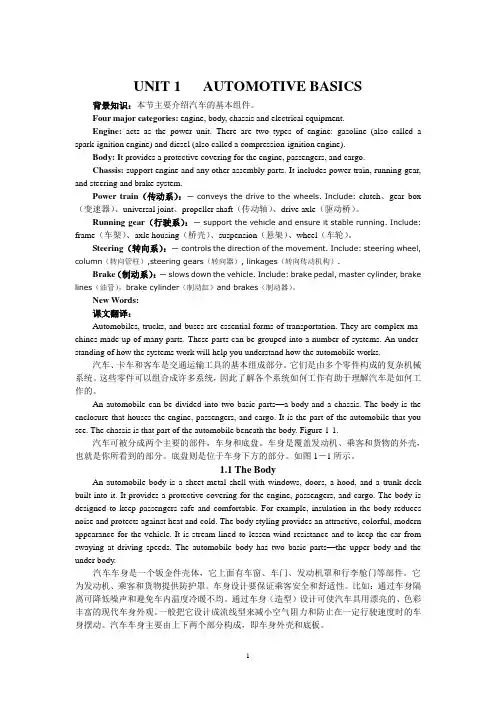
UNIT 1 AUTOMOTIVE BASICS 背景知识:本节主要介绍汽车的基本组件。
Four major categories: engine, body, chassis and electrical equipment.Engine:acts as the power unit. There are two types of engine: gasoline (also called a spark-ignition engine) and diesel (also called a compression-ignition engine).Body: I t provides a protective covering for the engine, passengers, and cargo.Chassis: support engine and any other assembly parts. It includes power train, running gear, and steering and brake system.Power train(传动系):― conve ys the drive to the wheels. Include: clutch、gear box (变速器)、universal joint、propeller shaft(传动轴)、drive axle(驱动桥)。
Running gear(行驶系):― support the vehicle and ensure it stable running. Include: frame(车架)、axle housing(桥壳)、suspension(悬架)、wheel(车轮)。
Steering(转向系):― controls the direction of the movement. Include: steering wheel, column(转向管柱),steering gears(转向器), linkages(转向传动机构).Brake(制动系):― slows down the vehicle. Include: brake pedal, master cylinder, brake lines(油管),brake cylinder(制动缸)and brakes(制动器)。
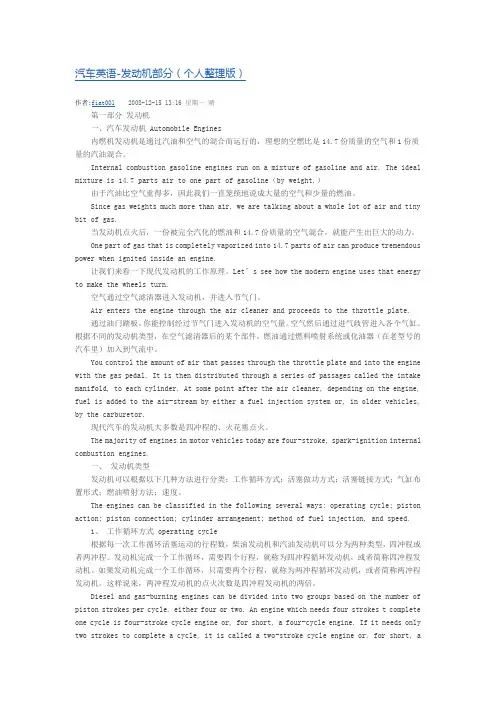
汽车英语-发动机部分(个人整理版)作者:fiat0012008-12-15 13:16 星期一晴第一部分发动机一、汽车发动机 Automobile Engines内燃机发动机是通过汽油和空气的混合而运行的,理想的空燃比是14.7份质量的空气和1份质量的汽油混合。
Internal combustion gasoline engines run on a mixture of gasoline and air. The ideal mixture is 14.7 parts air to one part of gasoline(by weight.)由于汽油比空气重得多,因此我们一直笼统地说成大量的空气和少量的燃油。
Since gas weights much more than air, we are talking about a whole lot of air and tiny bit of gas.当发动机点火后,一份被完全汽化的燃油和14.7份质量的空气混合,就能产生出巨大的动力。
One part of gas that is completely vaporized into 14.7 parts of air can produce tremendous power when ignited inside an engine.让我们来看一下现代发动机的工作原理。
Let’s see how the modern engine uses that energy to make the wheels turn.空气通过空气滤清器进入发动机,并进入节气门。
Air enters the engine through the air cleaner and proceeds to the throttle plate.通过油门踏板,你能控制经过节气门进入发动机的空气量。
空气然后通过进气歧管进入各个气缸。

Lesson 1. Petrol and Diesel Engines汽油发动机机和柴油发动机The explosive mixture of the petrol engine is provided by a carburettor, but in the case of the diesel engine the supply is effected by an injection or jerk pump which forces a shot of fuel into each cylinder in turn according to the correct firing sequence.翻译:汽油发动机由一个化油器输送可燃混合气体,而柴油发动机,由一个喷射泵或柱塞式燃油泵实现燃油供应,此泵根据正确的点火顺序把少量燃油依次压入每个汽缸。
The pump is actuated from a camshaft and the amount injected for each power stroke is extremely small at maximum output, indeed it may be less than 0.1 cm2 , Moreover, this charge must be metered with great and constant accuracy even while it is being variably controlled to regulate power from idling to maximum.It will be realised that efficient and economical running is largely dependent upon the fuel pump.翻译:通过凸轮轴驱动油泵。
每个功率冲程的燃油喷射量在最大输出功率时是非常微小的,实际上,可能小于0.1 cm2。
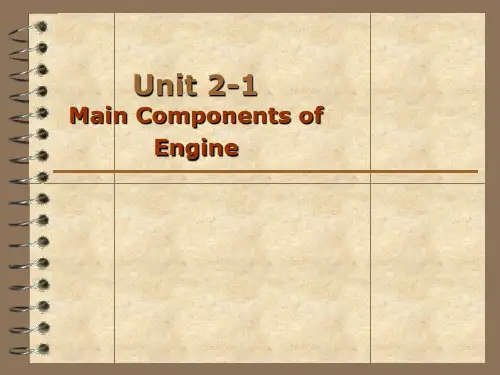



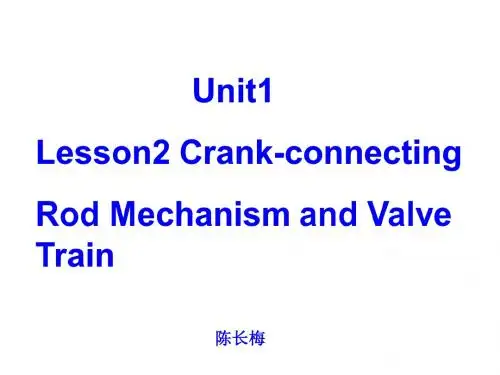
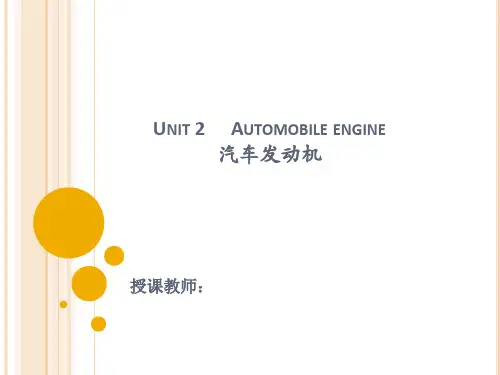
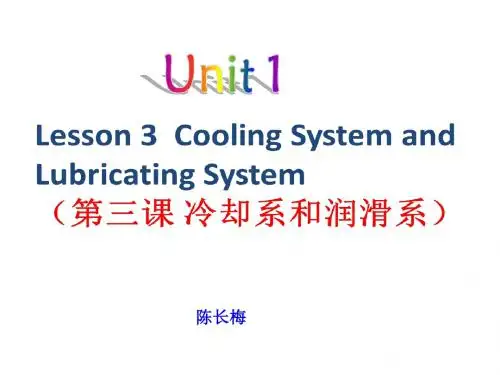
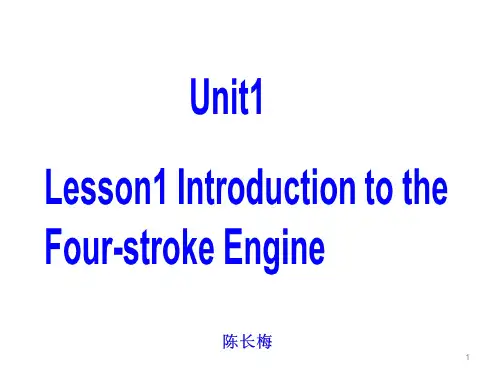
第一单元发动机分类及工作原理课文A发动机的分类所有的汽车发动机都是内燃机(ICE),就是将燃油在气缸内进行燃烧,并将燃烧产生的膨胀压力转变成转动力,用来驱动汽车。
所以说,发动机是动力源, 并被认为是汽车的心脏。
汽车发动机根据工作方式分为往复式发动机和转子发动机:报据发动机燃烧的燃料分为汽油机和柴油机:根据发动机的气缸数量和气缸排列方式分为直列发动机、V型发动机、对置式发动机和W型发动机。
往复式发动机和转子发动机往复式发动机也称为活塞式发动机。
该发动机采用一个或多个活塞在气缸内上下运动或前后运动,将压力转变为转动动能传递给汽车驱动轮(见图1-1)。
往复式发动机广泛应用现代汽车上。
转子发动机是于1954年研发出来的。
如图1-2所示,在该发动机中,有个三角形的转子在燃烧室内旋转。
膨胀气体使转子旋转,产生动力并排出废气。
转子发动机没有活塞和气门等往复部件。
转子发动机产生马力大、无振动,但其燃油消耗比往复式发动机要高。
汽油机和柴油机汽油机以汽油作为燃料。
采用火花塞点燃缸内的可燃混合气,产生动力使汽车行驶,如图1-3a所示。
汽油机也称为火花点燃式发动机。
该发动机的特点是转速高,运行平顺,结构简单,重量轻,成本低。
几乎所有轿车都采用汽油机。
柴油机以柴油作为燃料。
该发动机的工作原理足通过压缩缸内的空气使其升温,冉使喷油嘴喷入的柴油燃烧,产生动力驱动汽车(见图1-3b),所以也称为压燃式发动机。
柴油机要比汽油机的动力更强劲,燃油经济性更好。
常见于所有的大型货车、客车和部分轿车上。
直列发动机,V型发动机,水平对置式发动机,W型发动机通过气缸数最和气缸排列方式可以识别发动机结构。
当今所有的紧凑型轿车都配有4缸发动机,一些中型级轿车配有6缸发动机,大型轿车配有8缸或12缸发动机。
在多气缸发动机上,气缸通常以四种排列方式中的一种排列,有:直列式、V型、水平对置式和W型。
直列式发动机中的气缸按直线排列,采用一个气缸蓝。
几乎所有4缸发动机都采用该种排列(兄阁1-4)。